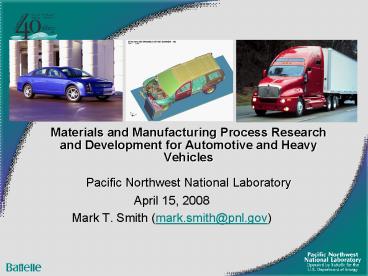Materials and Manufacturing Process Research and Development for Automotive and Heavy Vehicles Pacif - PowerPoint PPT Presentation
1 / 9
Title:
Materials and Manufacturing Process Research and Development for Automotive and Heavy Vehicles Pacif
Description:
Kevin Stork, Team Leader. Engine and Emission Control Technologies. Gurpreet Singh, Team Leader ... Kevin Stork. Non-Petroleum Fuels. Dennis Smith. Technology ... – PowerPoint PPT presentation
Number of Views:664
Avg rating:3.0/5.0
Title: Materials and Manufacturing Process Research and Development for Automotive and Heavy Vehicles Pacif
1
Materials and Manufacturing Process Research and
Development for Automotive and Heavy
VehiclesPacific Northwest National Laboratory
- April 15, 2008
- Mark T. Smith (mark.smith_at_pnl.gov)
2
Advanced Vehicle Materials and Manufacturing
Technologies
- PNNL Collaboration and DOE Funding
- DOE Program Offices
- Office of FreedomCAR Automotive and Heavy
Vehicle Materials and Manufacturing - Industrial Technology Program (ITP)
- Office of Hydrogen and Infrastructure Technology
- Industry Partners and Collaborators
- USCAR (DaimlerChrysler, Ford, General Motors)
- Heavy Vehicle OEMs (Freightliner, PACCAR,
International, Volvo, etc) - Boeing
- Tier 1 and 2 automotive and truck suppliers
- Material suppliers
- DoD- Army, Air Force, Navy
- Universities and National Laboratories
3
Vehicle Technologies Organization
Vehicle Technologies
Ed Wall, Program Manager
21st Century Truck Partnership Ken Howden,
Director
FreedomCAR Fuel Partnership Patrick Davis,
Director
Chief Scientist Dr. James Eberhardt
- Environmental Science and Health Impacts
Supervisory Engineer Rogelio Sullivan
Supervisory Engineer Steve Goguen
Engine and Emission Control Technologies Gurpreet
Singh, Team Leader
Materials Technologies Rogelio Sullivan, Team
Leader
Hybrid Electric Systems Tien Duong, Team Leader
Fuels Technologies Kevin Stork, Team Leader
Lightweight Materials Joe Carpenter
Combustion and Emission Control Ken Howden
Vehicle Systems Testing Lee Slezak
Advanced Petroleum Based Fuels Kevin Stork
Propulsion Materials Jerry Gibbs
Non-Petroleum Fuels Dennis Smith
Heavy Truck Engine Roland Gravel
Energy Storage and Power Electronics Tien
Duong Susan Rogers Dave Howell Steve Boyd
HTML James Eberhardt
Waste Heat Recovery John Fairbanks
Technology Introduction Dana OHara Linda
Bluestein
4
U.S. Petroleum Production and Consumption,
1970-2030
- Sources Transportation Energy Data Book Edition
26 and projections from the Annual Energy Outlook
2007. - Notes
- The sharp increase in values between 2005 and
2006 are the result of the data change from
historical to projected values. - Petroleum production includes crude oil, natural
gas plant liquids, refinery gains, and other
inputs, which include liquids from gas, liquids
from coal, and alcohols, ethers, petroleum
product stock withdrawals, domestic sources of
blending components, other hydrocarbons, and
natural gas converted to liquid fuel.
5
Effect of Automotive Lightweighting
- 6-8 (with mass compounding) increase in fuel
economy for every 10 drop in weight, everything
else the same - and/or
- Offset the increased weight and cost per unit of
power of alternative powertrains (hybrids, fuel
cells) with respect to conventional powertrains
6
Light-Duty Vehicle Trends
Adjusted Fuel Economy by Model Year (Three-Year
Moving Average)
Weight and Performance by Model Year (Three Year
Moving Average)
Source Light Duty Automotive Technology and Fuel
Economy Trends 1975 through 2004, U.S.
Environmental Protection Agency, April 2004.
7
Lightweight Materials Forming and Manufacturing
for Improved Efficiency
Thermoplastic Composites
Lightweight Glazing
Magnesium Alloy
Metal Matrix Composites
50 weight reduction
30 weight reduction
Reduces mass by 60
Aluminum Tailor Welded Blanks
Powertrain components - 40 weight reduction
Hydroforming
Superplastic Forming
40 weight reduction / 50 reduction in part count
35 weight reduction / reduction in part count
40 weight reduction / 10 X reduction in part
count
8
Overview of Fuel Cell Materials Needs
9
Advanced Materials and Manufacturing Technologies
for Fuel Efficient Vehicles
- Hybrid Materials Structures
- Electromagnetic Forming
- Superplastic Forming and Multisheet SPF
- Metals Formability
- Low-Cost Titanium Processing
- Metal Matrix Composites
- Friction Stir Welding and Processing/Surface
Modification - Low Cost Carbon Fiber (lignin, hybrid CF-glass)
- Predictive Modeling of Composite Properties and
Performance - Aluminum PU/SUV Frame Development































